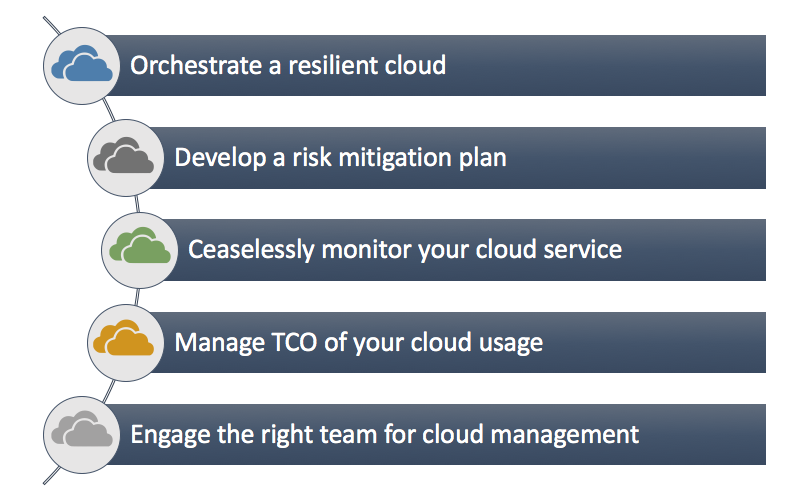Cloud management is complicated. Any business beginning its cloud journey should have a clear strategy to ensure successful cloud adoption. Certainly, it demands deep expertise to deliver desired results and avoid potential pitfalls. Managing the cloud is a very critical part of the cloud service model and presents several challenges that could hinder your cloud success.
There are several best practices essential for efficient cloud management that enable you to meet your business goals. In this article, we deal with five best practices recommended for any organization aiming for a well-run cloud.
Why Best Practices Matter for Cloud Management?
If you have just moved your storage, apps or website into a cloud network, your journey is not over yet! To save your company from the vulnerabilities and threats associated with cloud, you should have a clear cloud management strategy. Outages, poor performance, security risks and several other issues plague many organizations.
This is mainly because they are unprepared to handle the challenges of cloud computing. As a result, their businesses suffer lost revenues and strained customer relationships. The manner in which you manage your cloud can have a direct impact on its success. Avoid common pitfalls by following best practices for cloud management and ensure you have a failure-resistant cloud.
Can Things Go Wrong with Market-leading Cloud Providers?
SMEs and large organizations adopting the services of leading cloud providers like Amazon Web Services or Microsoft Azure rely on the brand’s promise. However, their cloud management lacks planning for the days when the cloud goes dark! When Microsoft Azure went TITSUP, users around the world were left helpless!
Amazon’s S3 outage in March 2017 knocked out several businesses big and small, yanked away from their storage, apps and websites. In fact, the outage was so bad that even Amazon couldn’t access its own dashboard!
What Are The Best Cloud Management Practices For Success In The Cloud?
Organizations with the best Cloud Management strategies can leverage the cloud, maintain agility and resist failure.
- Orchestrate a resilient cloud
- Develop a risk mitigation plan
- Ceaselessly monitor your cloud services
- Manage TCO of your cloud usage
- Engage the right team for cloud management

5 BEST PRACTICES FOR A WELL-MANAGED CLOUD
1. Orchestrate a resilient cloud
You can achieve high availability faster in the cloud if you understand the characteristics of a resilient cloud. The right way to build a resilient cloud is to follow all best practices recommended by your cloud provider. You should adhere to the guidelines throughout all stages of design, deployment, maintenance and management.
Prevent a single point of failure
One of the key items in the best practices checklist is to avoid any single point of failure. Deploy your compute instances, services, resources and other components as multiple instances spread over different data centers. Even if one region goes TITSUP, it doesn’t take down your whole business with it!
Deploying multiple instances is easier said than done because of many factors:
- Coding in redundancy is a good practice that is not always followed by developers.
- Extensive expertise is needed to design applications that can be configured to use multiple instances.
- Costs involved are too high
Market leaders for cloud service offer SLAs assuring availability. However, they have a clause in their agreements that these guarantees are not valid if you fail to deploy more than one instance of a role for each service. So understand cloud management complexities and design a resilient cloud.
2. Develop a risk mitigation plan
When disaster strikes, cloud management strategies will make a big impact. There is nothing worse than realizing that you have moved to the cloud, but the downtime is killing your revenue!
Plan for the risks, strategize a risk mitigation plan and train your employees. You will be able to deal with the issues quickly and respond effectively. Make sure you have the right disaster recovery plans, backup protection and other processes to maintain reliability. This way you are prepared to deal with a dark cloud when disaster strikes!
If you are running a 24×7 business that relies on your cloud environment’s uptime, effective cloud management should help you sustain even when your cloud is under threat.
3. Ceaselessly monitor your cloud services
You may have negotiated and signed your Cloud SLA to your satisfaction, but you can’t sit back and relax! You should monitor your cloud services continuously and make sure that your service provider is living up to the assurances (promised in the SLA).
Ensure that your network is performing to meet your expectations. Another commonly overseen issue is bandwidth, a core element of cloud solutions. If you don’t plan for your bandwidth needs and monitor usage, you could end up with cloud bandwidth issues.
Cloud Management practices aimed at careful monitoring will also help you recognize and avert security threats before they spin out of control.
4. Manage TCO (Total cost of ownership) of your cloud usage
Several small and medium-sized organizations drop out of cloud because they don’t know to manage costs and soon fizzle out.
The “Pay-As-You-Go” rate for the cloud is very alluring to businesses who only want to pay for what they use! But they don’t pay attention to limits, constraints, quotas and other terms associated with the rate.
There are several factors involved in evaluating the TCO for cloud services. For example:
- Cloud providers charge for the amount of storage, compute capacity, traffic, etc. The total cost will include all these different streams.
- Additional services bring forth extra charges that are not the same as typically added costs. Let’s say you are availing Elastic IP Address feature (permanent IP address for your application) of AWS. If you think that you are only going to pay when using your EIP, you are wrong. Amazon will charge you for your EIP when you are not using it!
- You should evaluate your load requirement and seasonal variations (for example, Christmas).
Once you understand how to assess and manage TCO of your cloud usage, you can work on optimizing for efficiencies.
5. Build a Cloud CoE (Center of Excellence) or outsource to a reliable cloud management service provider
A proven formula for cloud success is to have the right team with the best possible cloud expertise. A team with real-world experiences in cloud management can help substantially.
Even the most innovative technology can turn into a recipe for failure if the right talent does not back your business! Organizations who understand the value for a core cloud team invest in building a CoE to standardize best cloud management practices.
You moved your business to the cloud to focus less on IT, then why invest in another IT team for the cloud? Well, the alternative is to outsource cloud management to a reliable service provider.
Cloud management can be challenging if you fail to develop and implement a clear strategy. You should invest time and effort in understanding your business objectives and building a well-designed cloud. It is also important to plan for risks and threats, manage TCO and have the right expertise. Your company will reap maximum benefits from the cloud and you will be able to dedicate more of your resources to your core business.






